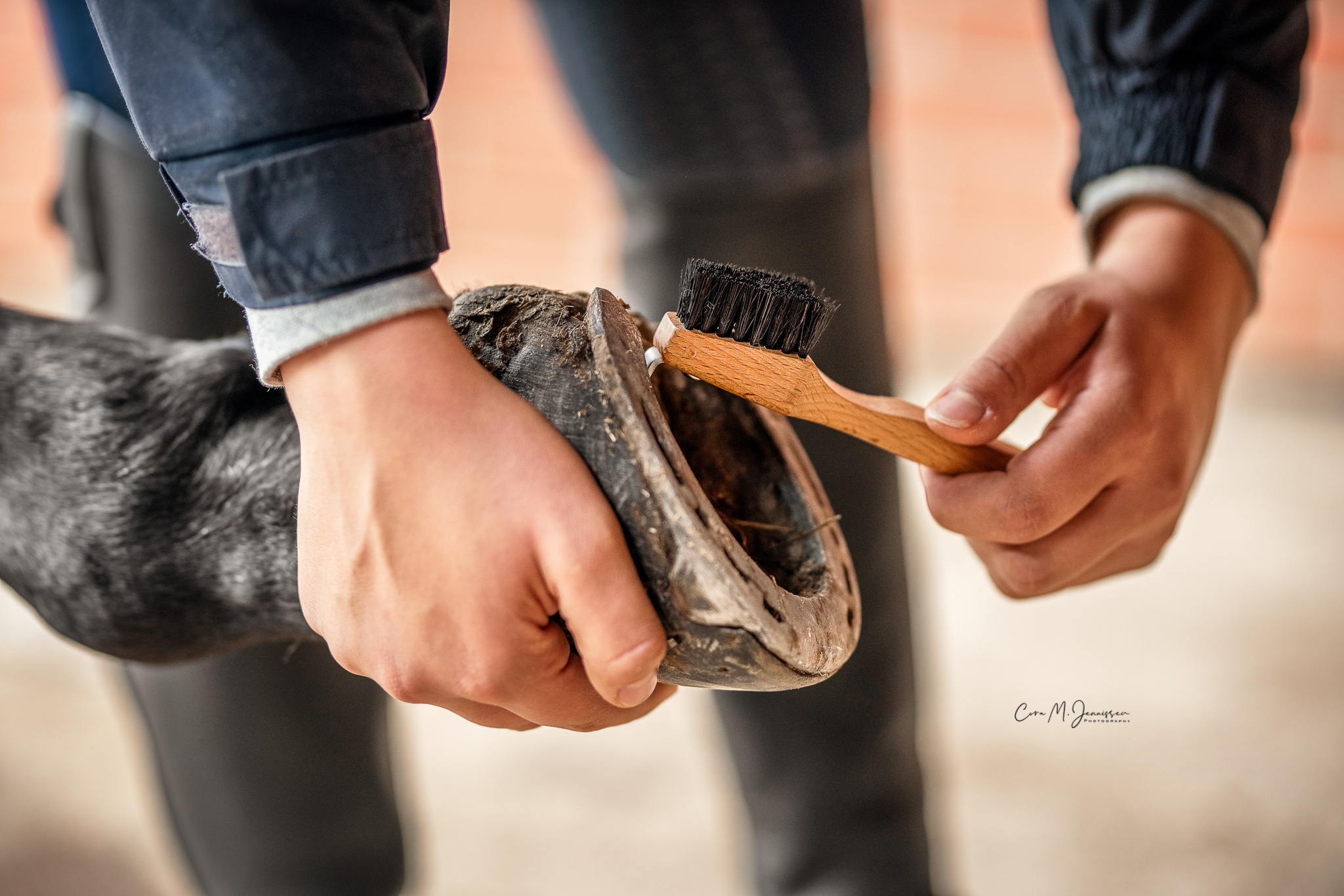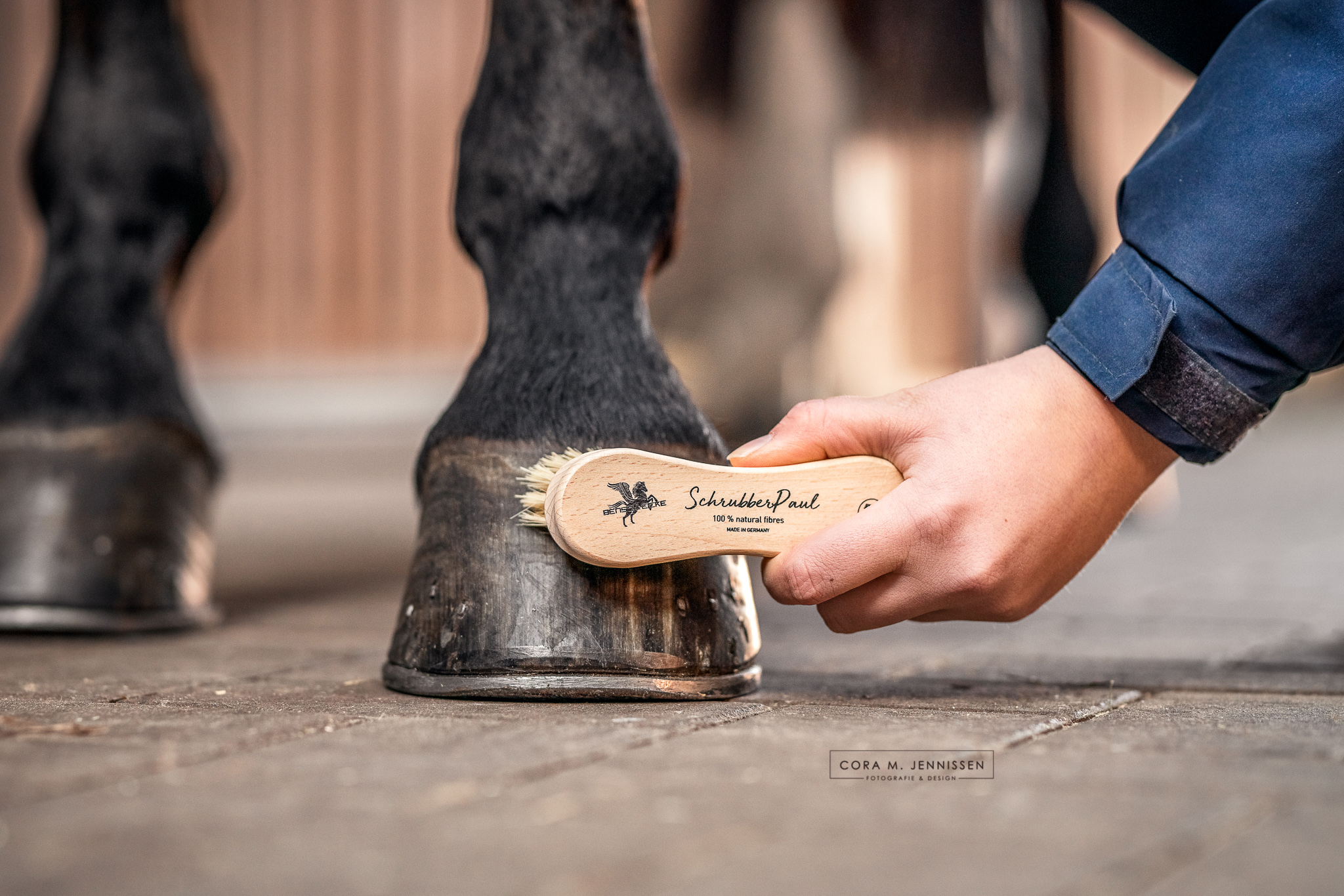
The right hoof care
April 18, 2019
Blog
Pferdepflege
The result "healthy hoof" is a result of the successful interaction of nutrition, care, husbandry and the bedding management that goes with it.
Due to today's ground conditions on which horses move, hoof growth and hoof wear often do not coincide. Therefore, regular hoof care and maintenance is essential. Depending on the abrasion, wearing hoof shoes or shoeing the hooves may be necessary and appropriate. Especially if the horses are often moved on gravel or asphalt, a shod hoof/hoof in a shoe is better protected from abrasion. Shoeing is also beneficial if the horse suffers from a misalignment of the hooves and this needs to be corrected. Horseshoes are also needed for screwing in cleats, which are used especially on slippery ground conditions.... Generally, however, it is healthiest for the horse to go barefoot ♥.
Nice to know - to keep your four-legged friend's hooves elastic, resilient and healthy!
- Feed a good mineral feed.
- The hooves should be cleaned and cleaned each day when leaving (and entering) the box.
- The bedding should always be dry.
- Permanent standing on "mud paddocks" and wet, muddy meadows should be avoided.
For regular hoof care to keep the hoof elastic and resilient, hoof ointment or hoof oil is particularly suitable. The moisture balance of the hoof is regulated and the horn stability is promoted. If you prefer a purely natural product, Natural Hoof Oil or Natural Hoof Cream is the best choice. The nourishing oils nourish the hoof horn and the antibacterial oregano oil protects at the same time.
- Brittle, dry, cracked hooves or tough hooves:
We always recommend a blood work check and a good mineral feed such as Dr. Eilers Special and then a course of treatment with our Natural Hoof Oil. Week 1: daily oiling, week 2: depending on the condition of the hooves, oiling can be adjusted to 4x a week. Week 3 and 4: oiling 3 times a week, then as needed.
Tip: If possible, oil hooves when they are freshly cleaned.
- Preventive care of the hoof frog:
To prevent frog rot and keep the hoof frog elastic and maintained, we recommend applying our frog and hoof spray after each trimming and additionally 1-2 times a week as needed. It puts a protective film over frog and sole and protects against bacteria.
- Care for acute thrush:
For acute thrush we recommend the use of our Maukosan - spray the affected areas 1-4 days 1to 2x daily, possibly also place a soaked cotton pad in the furrows to prolong the effect. When the affected areas are effectively dried out, then treat them 1x daily with Natural Hoof Oil. Use Maukosan again only when the areas become damp again. Regular cutting out/removal of diseased material helps tremendously with healing!
- Poorly growing hooves:
For poorly growing hooves we recommend a good mineral feed such as Dr. Eilers Special or a special hoof preparation such as our Biotin plus - sometimes it makes sense to feed both at the same time. In principle, a blood count check is also advantageous here. In addition, we recommend in combination our Bay Oil Express for the blood circulation and growth-promoting treatment of the coronet band.
- The hooves should be cleaned and cleaned each day when leaving (and entering) the box.
- The bedding should always be dry.
- Permanent standing on "mud paddocks" and wet, muddy meadows should be avoided.
Which care products for which hoof?
- Regular care for healthy hooves:For regular hoof care to keep the hoof elastic and resilient, hoof ointment or hoof oil is particularly suitable. The moisture balance of the hoof is regulated and the horn stability is promoted. If you prefer a purely natural product, Natural Hoof Oil or Natural Hoof Cream is the best choice. The nourishing oils nourish the hoof horn and the antibacterial oregano oil protects at the same time.
- Brittle, dry, cracked hooves or tough hooves:
We always recommend a blood work check and a good mineral feed such as Dr. Eilers Special and then a course of treatment with our Natural Hoof Oil. Week 1: daily oiling, week 2: depending on the condition of the hooves, oiling can be adjusted to 4x a week. Week 3 and 4: oiling 3 times a week, then as needed.
Tip: If possible, oil hooves when they are freshly cleaned.
- Preventive care of the hoof frog:
To prevent frog rot and keep the hoof frog elastic and maintained, we recommend applying our frog and hoof spray after each trimming and additionally 1-2 times a week as needed. It puts a protective film over frog and sole and protects against bacteria.
- Care for acute thrush:
For acute thrush we recommend the use of our Maukosan - spray the affected areas 1-4 days 1to 2x daily, possibly also place a soaked cotton pad in the furrows to prolong the effect. When the affected areas are effectively dried out, then treat them 1x daily with Natural Hoof Oil. Use Maukosan again only when the areas become damp again. Regular cutting out/removal of diseased material helps tremendously with healing!
- Poorly growing hooves:
For poorly growing hooves we recommend a good mineral feed such as Dr. Eilers Special or a special hoof preparation such as our Biotin plus - sometimes it makes sense to feed both at the same time. In principle, a blood count check is also advantageous here. In addition, we recommend in combination our Bay Oil Express for the blood circulation and growth-promoting treatment of the coronet band.














